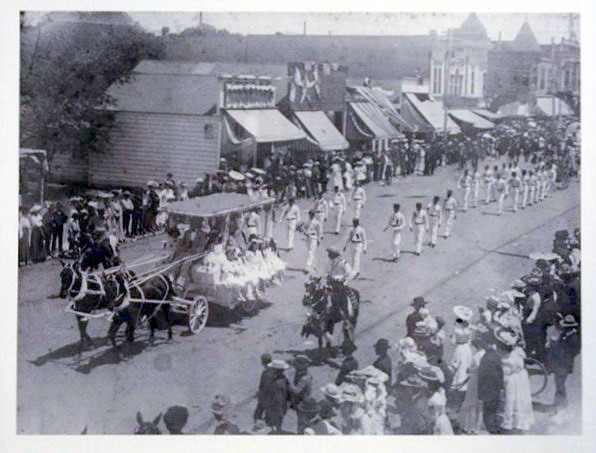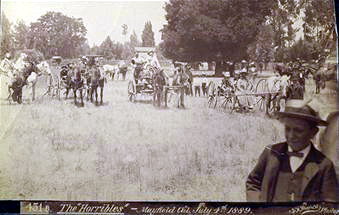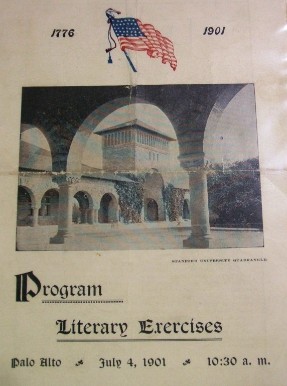The 4th of July: Summertime Celebrations
Patriotism in our country was different a century ago. While there were certainly detractors of the government back in the early 1900s, the overall level of trust that Americans had in the nation and its leaders was much higher. It's not necessarily that there is less love of country today, but the nature of the feeling had changed a great deal. It seems we are more critical, more cynical, less wide-eyed in our allegiance these days. Once most Americans seemed to presume that our country was always a force for good. Today it seems we’re often not so sure.
Widespread confidence lasted well into the 1960s as Ike and JFK led the nation through prosperous years fighting the Red Menace at home and abroad. Polls showed that trust in government was still close to 70% as late as 1966. Enter Vietnam. America’s questionable mission in Southeast Asia greatly undermined the public trust, as many began to wonder who the bad guys really were. Publication of the Pentagon Papers and other insider intelligence showed that the government was more than capable of bold-faced lies. Earlier, the civil rights movement had been a wake-up call to many Americans living in the glow of the 1950s --- for it was now apparent that not everyone had been living the American Dream. Then came the mother of all government deceptions --- Watergate. Since then the Iran-Contra cover-up, the Lewinski affair and the futile search for WMD in Iraq have further added to the skepticism. Today just 25% of Americans say they trust their government. It seems that national patriotism and support for those who are running things are not always in sync.
But a look back at American society a century ago shows a more innocent brand of patriotism --- indeed, a more innocent society. For evidence, one can look back at the Independence Day celebrations around the turn of the century. In our city of Palo Alto, for instance, July 4th was always a very big deal. And during three summers in particular --- 1895, 1901 and 1904 --- the city really pulled out all the stops.
The scale of these events was quite remarkable. For a town incorporated in 1894, the July 4th celebrations were quite ambitious, drawing hundreds of out-of-towners to Palo Alto. They were all-day affairs, beginning at daybreak with the singing of the national anthem and the ceremonial firing of the “National Salute” by two cannons. The 1904 celebration included a giant parade that stretched more than a mile, commencing at 11 o’clock with the explosion of 10,000 powder firecrackers. Holding a thousand small U.S. flags, the marchers proceeded through the downtown area past houses and storefronts decorated with red, white and blue bunting and patriotic paraphernalia.
The parades always included floats, which were particularly elaborate during the 1895 festivities. On display were national symbols --- the Liberty Bell, Uncle Sam, George and Martha Washington and the Goddess of Liberty --- accompanied by 44 little girls representing (what were then) “the several states.” There was also a “Red Man Float” that would certainly not be appropriate today. The Palo Alto Timesreported that “the members of the various councils were in Indian costume and their appearance and yells carried one back to the earlier days. Following this were a number of half-naked ‘Indian’ lads, a squaw with papoose and other appropriate features.”
There were great bounties of food at the celebrations. Rather than the family BBQs of today’s Fourth of July holiday, the 1904 feast was a community event for no less than 5,000 people. It did feature a similar menu, however. Barbecued meats, along with “assorted delicacies,” laid out at tables under a giant red, white and blue tent assembled near the corner of Ramona and University. The 1901 celebration included a free clam bake in which F.S. Gifford, an old-time New Englander, coordinated the baking of 3,000 clams in a brick-lined pit that was heated by a roaring fire.
During the 1904 party the touring Veteran Fireman’s Association of San Francisco were featured guests. They demonstrated how fire fighting was done in the “olden days” and performed the song, “When We Ran with the Old Machine.” Actually, they weren’t kidding --- the old machine, in fact, dated back to 1852. In a touching expression of appreciation, 500 of the townspeople marched with the First Regiment Band to Mrs. Jane Stanford’s house on campus, serenading her with a tribute to her late husband. She would later call it one of the “landmarks of my life.”
And of course, the Fourth of July wouldn’t be the same without some exhibition of the national pastime --- especially as baseball was never more popular than at the turn of the century. The 1904 match was staged between the Pacific and Western companies of the Southern Pacific Railroad, while in 1901, clerks had a chance to face their bosses away from the store and out on the diamond.
Those early celebrations were characterized by a lack of self-consciousness hard
to imagine today. For instance, patriotic singing was very popular and local citizens didn't hesitate to join the chorus. Along with the "Star-Spangled Banner," Palo Altans also belted out “America,” “My Own United States,” “American Republic” and “Columbia, the Gem of the Ocean” --- an old hymn that for some time was in the running to become our official national anthem. The festivities also featured a trained orator’s reading of the Declaration of Independence and a speech from a senator or some other dignitary. In 1895, Dr. Charles Decker rang in the day by exclaiming that “Today from every pulpit, glad, happy people sing their anthems of joy... All the States of the Union have donned their holiday attire and Palo Alto…will permit no locality to out-shine her in her offerings and her enthusiastic display of National love.”
There were lots of games --- not just for the kids, but for the adults as well. These days it's a little hard to imagine downtown businessmen participating in the “Fat Man’s Race,” “Doughnut-Eating Contest,” or “Three-Legged Pursuit,” but it was common in that time. In fact, J.F. Parkinson, future Palo Alto mayor, was the 1901 Fat Man’s champ, taking home a coveted box of cigars. Of course it’s even harder to imagine the merchants of today queuing up to catch a greased pig, which the 1901 program described as taking place following the animal’s “proper lubrication.” The event always proved popular since the reward for catching the pig was, in fact, the pig itself.
Non-athletic contests also entertained the crowd. One particular favorite was the “Parade of Horribles,” a July 4th tradition common in those days, in which locals dressed up in comically grotesque costumes. Prizes were also awarded for “Best Decorated Bike” and “Best Gentleman Waltzer,” although the contests for “Homeliest Woman on the Grounds” and “Best Looking Girl under 14 Years” would probably be left off the program today.
Long after children were in bed, the 1904 holiday carried into the evening with festivities that lasted until one o'clock in the morning. The grand ball, an illuminated bicycle parade, the firing of another 25,000 fireworks and a midnight
supper served at two downtown hotels kept stalwart patriots awake and celebrating. Only then was it time to say goodnight to Uncle Sam, thoroughly proved Dr. Decker’s earlier prediction that “Palo Alto…will permit no locality to out-shine her in her offerings and her enthusiastic display of National love.” []
Our Reader's Memories:
"Palo Alto used to have a lengthy fireworks display out past the Duck Pond. Families would drive out and park and watch the fireworks being set off. One year, about 1970 or so, the fireworks started very late - -- clearly there was some technical hangup. Then there was one firework shot off, and another long
delay. Then --- kaboom! --- every single firework scheduled for the evening went off at once, in a cataclysmic, out of control display. After a long period of silence, everyone went home.
Although there may have been one or two more years where they did fireworks out there, I never went to another 4th of July Fireworks celebration, anywhere. Why bother? It would never be better than that."
-Corry
Send Us Your Memory!

A parade on Fourth of July early in the century --- probably during the 1904 festivities. (PAHA)

A 4th of July celebration in Mayfield in 1889. (PAHA)

The program from the 1901 4th of July Celebrations.